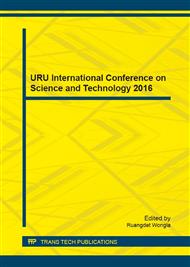[1]
R. Huirache, B. Pawelec, E. Rivera, R. Nava J. Espino, JLG. Fierro, Comparison of the morphology and HDS activity of ternary Co–Mo–W catalysts supported on Pmodified SBA-15 and SBA-16s ubstrates. Appl. Catal. B. Environ., 92: 168–84, (2009).
DOI: 10.1016/j.apcatb.2009.07.012
Google Scholar
[2]
I.B.W. Gunam, Y. Yaku, M. Hirano, K. Yamamura, F. Tomita, T. Sone, K. Asano. Biodesulfurization of alkylated forms of dibenzothiophene and benzothiophene by Sphingomonas subarctica T7b. J. Biosci. Bioeng. 101, 322-327 (2006).
DOI: 10.1263/jbb.101.322
Google Scholar
[3]
G. Mohebali, A.S. Ball, Biocatalytic desulfurization (BDS) of petrodiesel fuels. Microbiology 154, 2169–2183 (2008).
DOI: 10.1099/mic.0.2008/017608-0
Google Scholar
[4]
G. Dube, P. Osifo, H. Rutto Preparation of bagasse ash/CaO/ ammonium acetate sorbent and modelling their desulphurization reaction. Clean Tech. Environ Policy 16: 891–900 (2014).
DOI: 10.1007/s10098-013-0681-8
Google Scholar
[5]
N. Gupta, Biotechnology of desulfurization of diesel: Prospect and Chalanges. Appl. Microbiol. Bioethanol. 66: 356-366 (2004).
Google Scholar
[6]
J.J. Kilbane, Microbial biocatalyst developments to upgrade fossil fuel. Curr. Opin. Biotechnol. 2006, 17: 305-314 (2006).
DOI: 10.1016/j.copbio.2006.04.005
Google Scholar
[7]
M.M. Ramirez-Corredores, Biocatalyst in oil refining. Elseveir Ltd. AS. (2007).
Google Scholar
[8]
W. Li, X. Jiang, Enhancement of bunker oil biodesulfurization by adding surfactant, World J Microbiol. Biotechnol. 29: 103–108 (2013).
DOI: 10.1007/s11274-012-1162-7
Google Scholar
[9]
J.R. Gallagher, E.S. Olson, D.C. Stanley, Microbial desulphurization of dibenzothiophene: a sulfur-specific pathway. FEMS Microbiol. Lett. 107: 31–36 (1993).
DOI: 10.1111/j.1574-6968.1993.tb05999.x
Google Scholar
[10]
S-K. Rhee, J.H. Chang, Y.K. Chang, H.N. Chang, Desulfurization of dibenzothiophene and diesel oils by a newly isolated Gordona strain, CYKS1. Appl Environ. Microbio. l 64, 2327–2331 (1998).
DOI: 10.1128/aem.64.6.2327-2331.1998
Google Scholar
[11]
I.B.W. Gunam, IP.H. Prasetya, N.S. Antara, IW. Arnata, Y. Setiyo, IG.A.L. Triani, A.A.M.D. Anggreni, Biodesulfurization of dibenzothiophene by sulfur degrading bacteria isolated from Langkat North Sumatra, Proceedings 2; 1938-1943, (2015).
Google Scholar
[12]
I.B.W. Gunam, K. Yamamura, IN. Sujaya, N.S. Antara, W.R. Ayanta, M. Tanaka, F. Tomita, T. Sone, K. Asanao. Biodesulfurization of Dibenzothiopena and Its Derivatives Using Resting and Imobilzed Cells of Sphingomonas Subarctica T7b. J. Microbiol. Biotechnol. 23(4): 473–482 (2013).
DOI: 10.4014/jmb.1207.07070
Google Scholar
[13]
H.W. Araujo, Casullo, M.C. de Freitas Siva, Clarissa I Matos Lins. Oxidation of DBT by Serratia marcescens UCP 1549 formed biphenyl as final product. Biotechnol. Biofuel. 31-33 (2012).
DOI: 10.1186/1754-6834-5-33
Google Scholar
[14]
T. Matsui, T. Onaka, K. Maharuhasi, Benzo[b]thiophene Desulfurization by G. rubropertinctus strain T08. Appl. Microbiol. Biotechnol. 57: 212-215 (2001).
DOI: 10.1007/s002530100735
Google Scholar
[15]
L.M. Watkins, R. Rodriguez, D. Schneider, Purification and characterization of aromatic desulfinase, 2-(20 hydroxyphenyl) benzenesulfinate desulfinase. Ach. biochem. Biophys. 415: 14-23 (2003).
DOI: 10.1016/s0003-9861(03)00230-3
Google Scholar
[16]
Reichmuth, S. David., J.L. Hittle, dan H.W. Blanch. Biodesulfurization of Dibenzothiopena in E. Coli is enhanced by expression of a Vibrio harveyi Oxidoreductase Gene. Biotechnol. Bioeng., 67: 72-79 (2000).
DOI: 10.1002/(sici)1097-0290(20000105)67:1<72::aid-bit8>3.0.co;2-c
Google Scholar
[17]
K. Kirimura, K. Harada, H. Iwasawa, Identification and Functional Analysis of the Genes Encoding Dibenzothiophene-Desulfurizing Enzymes From Thermophilic Bacteria. Appl. Microbiol. Biotechnol., 65 (6): 703–713 (2004).
DOI: 10.1007/s00253-004-1652-0
Google Scholar
[18]
T. Ohshiro, Y. Ishii, T. Matsubara, Dibenzothiophene Desulfurizing Enzymes From Moderately Thermophilic Bacterium Bacillus subtilis WU-S2B: Purification, Characterization and Overexpression. J. Biosci. Bioeng, 100(3): 266–273 (2005).
DOI: 10.1263/jbb.100.266
Google Scholar
[19]
M.T. Madigan, J.M. Martinko, D.A. Stahl, D.P. Clark. Biology of Microorganism. Benjamin Cummings, Pearson Ltd. USA (2012).
Google Scholar
[20]
Y.J. Kim, J.H. Chang, K.S. Cho, H. W Ryu, Y.K. Chang, A Physiological study on growth and dibenzotiofena (DBT) desulfurization characteristic of Gordona sp. CYKS1. Korean J. Chem. Eng., (2004).
DOI: 10.1007/bf02705433
Google Scholar
[21]
N. Akhtar, M.A. Ghauri, M.A. Anwar, K. Akhtar, Analysis of the dibezothiophene metabolic pathway in isolated Rhodococcus spp. FEMS Microbiol. Lett. 301: 95–102 (2009).
DOI: 10.1111/j.1574-6968.2009.01797.x
Google Scholar
[22]
D.J. Monticello, Biodesulfrization and the upgrading of petroleum distillates. Curr. Opin. Biotechnol. 11: 540-546 (2000).
Google Scholar
[23]
B.R. Funke, G.J. Tortora, C.L. Case, Microbiology : An Introduction, Pearson Publish. USA, (2013).
Google Scholar
[24]
Y. Ishii, J. Konishi, T. Onaka. Thermophilic Carbon-Bond-Targeted Biodesulfurization. Appl. Enviroment. Microbiol., 8: 3164-3169 (1997).
DOI: 10.1128/aem.63.8.3164-3169.1997
Google Scholar
[25]
D. White, C. Susan D. Sutton, The genus Sphingomonas: physiology and ecology. Current Biology. Oakland, USA (1996).
Google Scholar
[26]
P. Xu, J. Feng, B. Yu, Recent Developments in Biodesulfurization of Fossil Fuels. Adv Biochem Engin/Biotechnol, 113: 255-274 (2009).
Google Scholar


